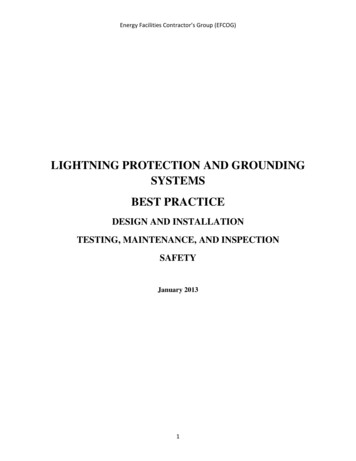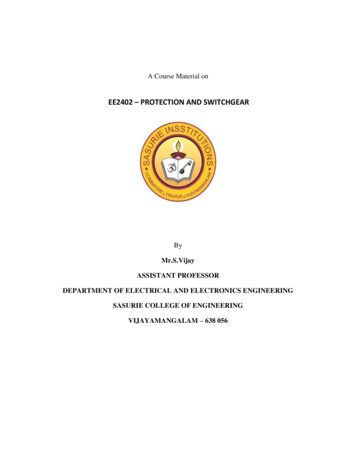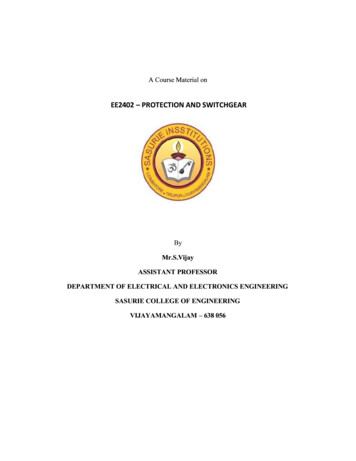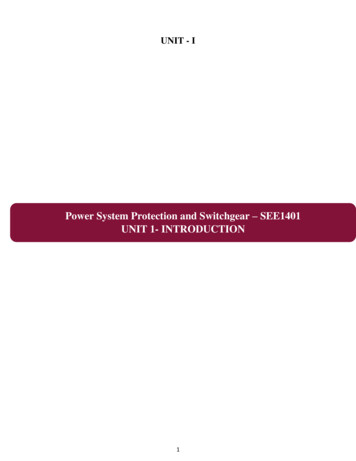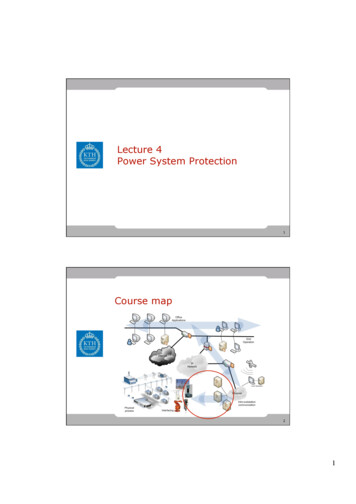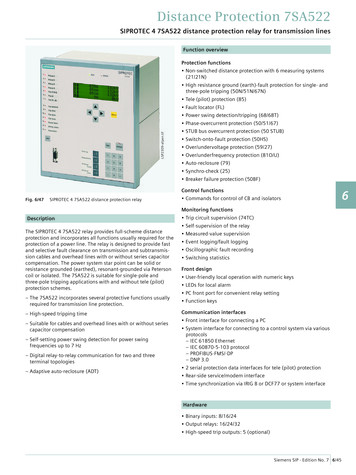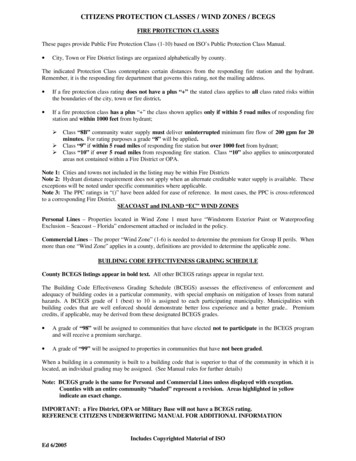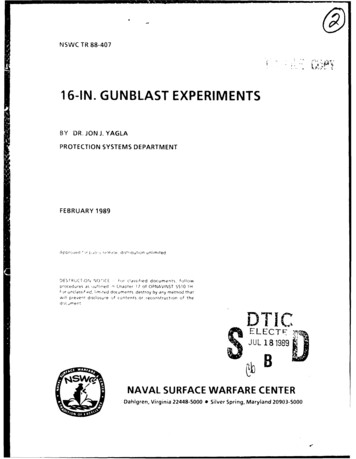
Transcription
NSWC TR 88-40716-IN. GUNBLAST EXPERIMENTSBY DR. JON J. YAGLAPROTECTION SYSTEMS DEPARTMENTFEBRUARY 1989AppOr' ,nr erifj.r,-eP ,edisrr'uto on unlimitedDESTRUCTION NO'ICE or classified documents, f0 l lowprocedures as uuthned n Chapter 17 of OPNAVINST 5510 1HF jr unclassf ed. bn,ted documents, destroy by any metnod that,iiPrevent disclosure of contents or reconstruction of thedosDTICmentIIISELECJUL181989NAVAL SURFACE WARFARE CENTERDahlgren, Virginia 22448-5000 0 Silver Spring, Maryland 20903-5000
REPORT DOCUMEN4TATION PAGER*R4(' (.iI 'February 1989t .I-(),'44''. rL[.'4,co)'4'4Final-I'4N4Y BI 16(416-IN. GUNBLAST EXPERIMENTSDR. JON J. YAGLANaval Surface Warfare Center (1113)Dahigren, VA 22448-5000NSWC TR 88-407Department of Defense Explosives Safety BoardRm. 856C, Hoffman Bldg. I, 2461 Eisenhower Ave.Alexandria, VA 2233 1-0060Approved for public release; distribution unlimited.This report describes the blast wave from the the 16-in, naval gun. The emphasis is onthe physics of the blast wave. The blast wave is described in sufficient detail to enabledevelopment of mathematical models for the loading and response of ship and equipment andto predict far field noise levels.blast wave, mathematical models, far field noise levels, 16-in, navalgunL \CLAssIF':IUNCLASSIFIED;IUNCLASS[IFID
NSWC TR 88-407FOREWORDThe work in this report was sponsored by Dr. Jerry Ward of the Department ofDefense Explosives Safety Board. The experimental data reported are the result of16-in. gunfirings conducted in support of the Battleship Reactivation Program. Theexperiments were conducted at the Naval Surface Warfare Center, Dahlgren,Virginia, and aboard U.S.S. Iowa (BB 61) and U.S.S. New Jersey (BB 62).The information in this report was presented at the International Conference onBallistics held in the People's Republic of China, 25-28 October 1988. Theconference was sponsored by the China Ordnance Society and held at the BallisticResearch Laboratory/China located at the East China Institute of Technology inNanjing.The conference was attended by 141 ballisticians (see pages iv and v) from theUnited States, Denmark, France, Federal Republic of Germany, Japan, Pakistan,Poland, Sweden, and Switzerland. Also in attendance was Professor Li Hong-Zhi,President, East China Institute of Technology, where he remains an activeresearcher and mentor for selected graduate students. On page vi is a photographpresented to the author by Professor Li. The photograph shows the muzzle flowfrom a 7.62-mm rifle, fitted with a special muzzle device to create additional blastwaves in the transverse direction. The photograph was taken with the new YA-16multiflash high-speed camera, which was invented by Professor Li. The cameracan take 16 pictures at computer-controlled times with a precision of 10-6 sec withtime resolution of 0.3 x 10-6 sec. It has a resolution of 40 line pairs/mm. ProfessorLi received the gold medal at the Beijing International Exhibition of Inventions forthe YA-16 multiflash camera.This report was reviewed by Dr. Francis H. Maillie, Head, Ship EngineeringBranch; and F. B. Sanchez, Head, Systems Safety/Security Division.Approved by:M. TINO, HeadProtection Systems DepartmentorDTIC TABUnannouncedJust iticatioByquDistributloq Availability CodesAvail and/or---iiDist/,,JSpeoial.A
NSWC TR 88-407InternationalConference on Ballistics, People's Republic of China('25-28 October 1988)iv
NSWC TR 88-407INTERNATIONAL CONFERENCE ON BALLISTICSREPRESENTATIVE LISTCanadaSek Kwan ChanYang Xin QuanXu Ming YouLi Yuni ELi Zhen YanTan Xue QingChinaZeng Ying ChaoZhu Li YingPu FaZeng Si Mir.Ma Da WeiWang HaoLin XiaoLiu Ya FeiYou Quo ZhaoWang Ru CeXu Hou QianLiu Shi PingSong MingRui Xiao TingYang Qi RenZhao Run GuiZhao Guo Zhi *CaiBao Ting YuShi Zhi YongWei Jian QuoLi Qi MingLiu Chang LiRen Zao XingRuan Zhong GaoZhang Xing SheZhang Qiu BinWang Ming HaiWei JiaHuang Hai ChengQin Ying XiaoZhang Shun YiLi DeJunCui Xin JunLiu Nai ShengHe Shun LuSong Chong QinYe Dao HaiShen Jin H uaLu De YeWang Zhong YuanQu Zuo JiaZhang Fu XiangWei Hui ZhiDong shi YanGuo Xi FuWang Nan YarnQiu Feng ChangChi Shu YiLi Kai RongHu Zheng ZhongLin Zai BiaoZhang Shi QingTan KaiHui DongLu Fu ShengZhao Han YuanYang Zhi YuanSongdunTianLiu Meng XiaJiang H ao ZhengShong Pi JiHan WenWang Ji HaiHua JingDong Yong ZhongFan HengZhou Lan TingLu YuJiao Hua NanZhang Zhen DuoChen Jian ZhongYu QiDing Ze ShengXue Xiao ZhongSu DaiLai Bai TanZang Quo CaiOu Yang Chu PingQiu Pei RongChen Zhang QingQiu Guang ShenWang Jian XinTang Rui FengZhu He SongZhou Yan HuangYang Min TaoQuo Shi PingWan Li MingHuang Zhcn YaHu Jun WeiYao De ShengLi Lu YingLiJiMinNi Ming ChengWang Yu HunWang Dong HuiZhang Yuri FaXu Shao ZiZhao Ke ShengLiao Xin QuanZhang YiThomas C. MinorJon J. YaglaLouis ZernowLi Hong ZhiYuan Zeng FengRobert J. EichelergerGao Sen LieJin Zhi MingWang Min ZhongCao rel GuiSean P. O'DarAndrew MarkVDenmarkLars Tingleff LarsenFrancePaulin Jean LouisIsler JeanMeunierFederal Republic ofGermanyEberhard SchneiderMuller Kurt DirtmarFornrt Jean-PierreJapanHitoshi MiyoshiPakistanM. S. BokhariGhulam SarwarTaria MasoudPoland'frebinski RadoslawSwedenFlygar Svrn-ErikGunnar MedinAnders NordellJanzon BoSwitzerlandGustav H. GautschiU.S.A.Charles H, MurphyHerman KrierJoer F. Crider
NSNC 'FR 88-407Th is photograph-wans taken ith tho, riu' YA - 16 rn ultiflash high -sped canicra,invented by' ProfessorLi Hong -Zhi, Prcsident1, East (.h ina Institultv ofTechnology. The photograph shtows the mnu zzle- flow, from a7.62 -mm rifle fitted itiIh a pcalItrnu.7l(' (h'ice to createdIirection.additional blast iL('cs in 1/ic tran.urse
NSWG TR 88-24 1CONTENTSPageINTRODUCTION .1BLAST EXPERIMENTS WITH A 16-IN. NAVAL GUN.2FAR PROPAGATION OF 16-IN. GUNBLAST.6SUMMARY.REFERENCES8.9APPENDIX--FIGURES SUPPORTING 16-IN. GUNBLASTEXPERIMENTS .11DISTRIBUTION.(1)vii
NSWC TR 88-407INTRODUCTIONThis report describes the blast wave from the 16-in. naval gun. The emphasis inthis section is on the physics of the blast wave. In the following sections, the blastwave is described in sufficient detail to enable development of mathematical modelsfor the loading and response of ships and equipment and to predict far field noiselevels.One of the most interesting of all wave phenomena is the blast wave. The blastwave is discontinuous, nonlinear, and moves through the medium at a speed greaterthan the speed of sound. Unlike sound waves, which all travel at the same speed, thestronger the blast wave, the faster it travels. Blast waves asymptotically approachthe speed of sound as they weaken. The blast wave consists of a discontinuous jumpin the thermodynamic properties at the wave front. Upon arrival at a point in space,the pressure, density, and temperature jump almost instantaneously to new values;and the medium is instantly set in motion in the direction of propagation of thewave. For example, a wave with a discontinuous jump in pressure of 10 psi travels ata speed of 1420 ft/sec (967 mi/hr). The fluid velocity behind the wave is 436 ft/sec(297 mi/hr) in the direction of travel of the wave.Items in the path of the blast wave experience both a discontinuous change andunbalance in pressure as the blast diffracts around them and a substantial gust-likeload due to the motion of the medium. A structure that may not be sensitive to thepressure load may be quite sensitive to the gust load and vice versa.Figure 1 (see the appendix) shows the major topside weapons and equipment onthe modernized U.S.S. Iowa- (BB 61) class battleships. Figure 2 shows Iowa firing abroadside with her main battery of nine 16-in. guns. Figure 3 provides a closer viewof a salvo being fired from U.S.S. New Jersey (BB 62).Figure 4 shows a blast wave leaving a 16-in. gun barrel. "Section view" representations are shown of the blast wave in the horizontal plane at two times aftergunfiring. The wave is nearly symmetrical about the gun axis and has a distendedspheroidal shape. The radii along the axis are longer, and the radii behind the gunare shorter. The pressure is shown as the measure of strength of the waves. There isa short period of negative overpressure and negative velocity that is not shown in thediagrams. The wavelets are drawn to scale from data obtained throughexperimental 16-in. gunfirings at the Naval Surface Warfare Center (NSWC),Dahlgren, Virginia.1
NSWC TR 88-407A blast wave from a 16-in. gun as it approaches the forward Close-In WeaponsSystem (CIWS) sponson on New Jersey is shown in Figure 5. Again, the wave isdrawn to scale from experimental data. The wave would diffract around the CIWS,then reflect off the ship's bulkheads. The reflections would then load the equipmenton the sponson from behind. The intensity of the blast wave at the CIWS governs theallowable firing arc of Turret No. 2.A detailed experimental investigation of 16-in. gunblast was carried out to designfiring zones for the battleships and to develop improvemrints for battleshipequipment. The experiments were carried out with a 16-in. gun at Dahlgren, onIowa, and on New Jersey.B LAST EX1)ERIMENTS WITH A 16-IN. NAVAL GUNThe initial experiments for the Battleship Reactivation Program were conductedat the Dahlgren range, which consists of 20 miles of open water on the tidal PotomacRiver, 50 miles south of Washington, D.C. The gun line has a single 16-in./50-calibergun mount that was used to conduct the experiments. Pressure data were taken at34 locations around the gun.The first set of experiments was conducted to obtain "near field" data andmeasured blast overpressures out to distances of 200 ft (2 psi) from the muzzle. Thisis the region of interest for shipbuilding and equipment design. Furtherexpt.riments were conducted to measure the "far field" propagation out to distancesas far as 28 miles.Three different arrangements of the instruments were used for conducting thefiring. Twelve rounds were fired with ea-h instrumentation array. The first arrayused 10 transducers along the 45-, 75-, and 125-deg radials. The second array used13 transducers located along the 60-, 90-, and 150-deg radials. The third array used13 transducers along the 15-, 30-, and 105-deg radials. The instrumentation isshown in Figures 6 and 7.The battleships employ several types of 16-in. ammunition. Full propellantcharges or reduced charges can be fired. The full charge consists of 660 lb ofsmokeless propellant. The reduced charge consists of 330 lb of propellant. Reducedcharges have the advantage of better accuracy (due to more consistent initialprojectile velocity) and less wear on the gun. There are two weights of projectiles inuse, 1900 and 2700 lb. In an operational situation, the type of charge and projectileis selected based on the characteristics of the target, the range, and what is availablein the magazine.A second purpose of the 16-in. gun experiments was to measure the performanceof 16-in./45-caliber propellant and to determine the effect of projectile weight. Thereare no 16-in./45 caliber guns left in naval service, but a large quantity of propellanthad been saved. SPD-9606 and SPDN-10494 propellants for the 16-in./45-caliber2
NSWC TR 88-407gun and 16-in./50-caliber gun, respectively, were employed. The 1900-lb highcapacity (HC) and 2700-lb armor-piercing (AP) projectiles were used. Thesevariables, plus relocating the instruments every 12 rounds and adjusting the 16in./45-caliber propellant charge in the course of the experiment, created aconsiderable database that required a formal statistical analysis. Reduced chargeswere not used in the experiments.Statistical tests of the database showed that the normal round-to-round variationin blast overpressure exceeded the variation due to propellant type and projectileweight. The data from all 36 rounds were then analyzed as though the experimentalconditions were constant. The good agreement with later data from New Jersey andIowa justified the approach.A complication arose in analyzing the data. The 16-in. gun propagates damagingoverpressures over such distances that the effects of the ground surface in front ofthe gun could not be neglected. Figure 8 shows the 16-in. gun firing horizontally.The blast wave soon arrives at the surface and reflects upward. Initially thereflection pattern is "regular," although the angle of incidence for the nonlinearwave is not equal to the angle of reflection. After a critical angle of incidence, thepattern changes to Mach reflection, where the incident wave and the reflected waveare connected to the reflecting surface by a third wave called the Mach stem. Manyof the outer instruments were located in the Mach reflection region. The data fromthese locations could not be used to predict free field overpressures until adjustmentswere made.The correction procedure was developed as follows. The blast felt at a distantpoint, such as "P" in Figure 8, would be equivalent to the blast from the real gun, if itwere fired in free air, plus the blast from a virtual gun fired in free air from beneatha plane of symmetry. The total propellant fired would be twice the service charge. Ifthis larger charge were fired out of a single larger gun in free air in the plane ofsymmetry, the same blast would be felt at "P." So the blast at "P" measured in theexperiment is equivalent to the blast that would have been measured in free air froma correspondingly larger gun.To a first approximation, all guns are scale models of one another and so are theirblast fields.l If the larger gun would be 21/3 times as long and 21/3 times thediameter as the 16-in. gun, then its chamber would have twice the volume and firetwice the charge. The pressure at "P" should therefore be plotted at a new distancereduced by the factor 2-1/3 . For example, the data prom instruments at 200 ft wereall in 'ie Mach stem, and are therefore plotted at a reduced distance of 159 ft. Thedata from the various radials are plotted in Figures 9 through 17. Also plotted in thefigures are a number of scattered points that were measured at various locations inthe New Jersey experiments. 2 ,3 It is apparent that the 16-in. gunblast is notprecisely repeatable.The detailed structure of the blast wave was studied through carefulmeasurements of high-speed photographs of blast waves taken during experimentsat Dahlgren and firings from New Jersey. The blast wave was clearly visible in someof the films. The film images were projected onto a large screen overlay, and the3
NSWC TR 88-407shock wave was carefully drawn for each frame in the motion picture sequence. Theprojectile was also visible in each frame of the sequence. Its speed was measuredduring the experiments with a Doppler effect radar velocimeter, and the speed andprojectile location were used to calibrate the images. The images were then digitizedfor input to a Computervision CADD (computer-aided design and drafting) draftingsystem. The shock wave propagation from the muzzle is shown in Figure 18. Thetechniques employed in the analysis are explained in detail in Courter. 4The field line method, 5 was used to further analyze the data stored in theComputervision system. With the field line method, one constructs a manifold of theorthogonal trajectories of the shock front. The orthogonal trajectories thus computedare called the field lines. The shock can be thought of as propagating along the fieldlines. Numerical differentiation along the field lines provides velocities that can beused in Rankine-Hugoniot equations to calculate the pressure behind the shockfront. The field lines for Figure 18 are shown in Figure 19. A seventh-order splinecurve-fitting routine was used to generate the shock wave profiles. The field lineswere constructed by using an iterative shooting method for projecting field linesegments from the shock wave. In regions of significant curvature, the field lineswere also constructed with the use of splines.The motion of the interface (contact surface) between the expanding propellantand the shocked air was also studied. The geometry of the contact surface is verycomplicated due to instability and turbul nce. The method of characteristics wasused to compute properties of the flow between the shock wave and the contactsurface. The field line data or pressure sensor data can be used to form a noncharacteristic line of initial values. The method of characteristics can then beemployed to compute the density, pressure, and sound speed distribution betweenthe shock and the contact surface. Method of characteristics calculations were4carried out, as described in Courter.The calculations were not completely successful due to problems with the data.However, several important conclusions were possible. First, the blast wave does notpropagate as predicted from simple expanding piston models. Rather, it bothaccelerates and decelerates several times during the early development of the flow.The trajectories for 0-, 30-, and 45-deg radials are shown in Figure 20. The inflectionpoints on these curves indicate a speeding up of the contact surface and shock wave.This is only possible through additional energy being added to the flow. We believethat combustion in the turbulent mixing region at the interface is an importantenergy source and leads to the phenomena of a flash-driven blast wave. Second,observations and photographs of numerous 16-in. gunfirings show that each fireballis different and that the fireballs are not symmetrical about the gun axis. This isbeleved to be the main reason for the round-to-round statistical variation in theblast data from the 16-in. gun.Analytical expressions for the peak overpressure in the blast field were developedfrom the plots in Figures 9 through 17. The simplest expression one can hope for is ofthe formP A(O)r (O)(1)4
NSWC TR 88-407where P is the overpressure in psi, AM) and o(()f) are functioms )fthe aziI1Ith angle,H: and r is the distance measured from the gun. The coefficient. .%, determines thedirectivitv: and the exponent, (1 . gives the rate of decay with distance. This formulaimplies an exponential decay of"overpressu 'e a1 nIg a given radial and allows fordifferent slopes in different directions. This approximate formila applies to all gunsstudied thus far. Figures 21 and 22 show the approximate decay of pressure and theangular dependence of. and A.The range of ( in the near field for the experiments, from Figure 22, is 1.32 to1.52. Various investigators have presented values in the range of 1.02 to 1.44 forvarious explosive phenomena in the pressure range of interest. For very intenseblast waves, for example near the surface of a high-explosive charge o)r near anuclear explosion, Lhe wave motion is highly nonlinear: and the decay is very rapidwith distance. In this extreme the exponent may be as high as 3. In the otherextreme of an infinitesimal amplitude wave traveling in an ideal gas, the exponenthas the theoretical acoustic limit of 1. '[he present experimental results lie betweenthese limits. As the wave propagates out to lower overpressures, say beyond I psi,the exponent should decrease with distance to the lower range of 1.0 to 1.1. Theactual value is difficult to determine experimentally because atmospheric refractionhas a pronounced effect on the intensity observed at distant points. Elaborateexperiments have been conducted to determine the limit, and the results remaincontroversial. The limit value of 1.1, which is based on theoretical calculations for a1-kiloton (kt) nuclear explosion in Needhamfi has been incorporated into the ANSIstandard. 7More accuracy than that available from the above formula was required forplanning the structural test firings on New Jersey. More elaborate expressions werefound for the curves, as shown in the Figures 9 through 17. The coefficients for eachradial were then curve-fitted to further expressions in order to follow the angulardependence of the blast field. Again, high-order splines were used to model the data.The final result is the overpressure contour curve in Figure 23. These curves wereused with excellent results in the design of 16-in. gun experiments conducted on Ne,Jerse.y2 1. and Iota., Contours of positive duration are shown in Figure 24. Contoursof impulse are shown in Figure 25. The impulse is defined as the time integral ofoverpressure during the positive phase, and the units aire psi-ms. The duration andimpulse curves were hastily prepared and are not of the same quality as theoverpressure contour.The overpressure contour was updated after the structural test firings on NewJersev. The guns were fired at various trains and elevations. Therefore. theinstruments were not on the radials used for the I)ahlgren experiments. Theexperimental data points were "'rotated" onto the nearest 15-deg multiple thro ugh aformula based on Taylor's series of multivariable calculus and partial derivatives of'the analytic expression for Figure 23. This allowed the additional data pointsobtained aboard ship to be used to enlarge the database and improve the accuracy (ifthe blast pressure contour dra'ving. The rotated data points measured aboard shipare scattered about at various distances in Figures 9 through 17. The data pointsmeasured at l)ahlgren are clustered at specific distances. A summary of the 16-in. ,,i5
NSWC TR 88-407gunblast efforts as relate to shipbuilding and equipment for the BattleshipReactivation Program is documented in the Naval Engineer'sJournal.9FAR PROPAGATION OF 16-IN. GUNBLASTThe far propagation of 16-in. gunblast was initially studied during experimentsin 1984, conducted in Dahlgren and Puerto Rico.10 The study covered ranges from10 to 36 nmi.Interest in 16-in. gunblast propagation into the far field was renewed in 1987 inconnection with research on the propagation of blast from accidental explosions ofunderground munitions storage facilities. This report is an outgrowth of a paper on16-in. gunblastl I invited to the Air Blast Exiting from Tubes Workshop sponsored bythe Department of Defense Explosives Safety Board and the Norwegian DefenseConstruction Service. The purpose of the meeting was to share data and improveunderstanding of the flow from tunnel explosions.The experiments of Yagla and Soo Hoo, 12 Soo Hoo and Moore,1 and Pater, 13 ,14show that most guns are reasonable models of one another. Their blast fields scale astheir linear dimensions. The blast emerging from the mouth of a tunnel, say 10 ft indiameter, may be geometrically similar to the blast from a 16-in. gun, with a scalefactor of 7.5 on all linear dimensions of the flow.The far propagation is strongly dependent on atmospheric conditions. Theexperiments in NSWC TR 86-19110 used data measured at ranges of 10 to 36 nmi inthe vicinity of Dahlgren, Virginia, to make predictions for noise in the vicinity ofVieques, Puerto Rico, as a result of battleship gunnery exercises and qualificationfirings. The formula for the sound pressure level that resulted from the Dahlgrenfirings wasSPL(dB) 117.5- 28.76 logR 7.15(1 cosO)(2)Here R is the distance in nmi from the gun and 0 is the azimuth measured from thegun axis. The last term is the directivity, which accounts for the variation ofintensity with azimuth. The sound pressure level is defined by the formulaSPL(dB) 20 logzp/pr(3)where the reference pressure, Pr, is 2.9x10- 9 psi. The formula shows that theoverpressure at a 1-nmi distance along the trajectory is 131.8 dB. Atmosphericrefraction can alter the predicted bound pressure level by as much as 20 dB. Theformula is for a "mean expected value" in that it was obtained by averaging a largebody of data. However, the last term, the directivity, has no free constants and wasassumed based on the work of Pater. 136
NSWC TR 88-407The data from References 9 and 10 were analyzed by Reed. 15 He found that adirectivity of the form b(1 cos0) 1/2 would provide a slightly better fit to the data.Greater precision is needed for the analysis of data from underground storagefacilities and the determination of safe distance criteria. The above formula wasdeveloped for data in the range of 10 to 36 nmi. Blast is important in the design ofunderground munitions storage facilities so that safe distances for houses and otherinhabited structures can be determined. The region of interest for undergroundtunnel explosions is in an intermediate range of distances between the near field,which was studied out to 2 psi, as originally done for the design of battleshipequipment installations and the far field as discussed above. A third set ofexperiments was authorized by the Department of Defense Explosives Safety Boardto fill in the data for the "intermediate" field. The board also requested a study of thedecay exponent so that other tunnel explosion data could be correlated.The data for the near field, intermediate field, and far field for azimuths of 30, 45,60, 75, and 90 deg are plotted in Figures 26 through 30. Substitution of equation 1 inequation 3 shows that coefficient of logR in equation (2) is 20 a. The coefficients areshown on each plot for each radial. The exponent, a , for the far field is plotted onFigure 22.The laboratory is concerned about the noise levels propagated into thesurrounding community. There are three main concerns. The first is for the hearingsafety of people in the community. Secondly, the laboratory makes every effort toavoid property damage in the community. The third concern is to minimizeannoyance and annoyance complaints. The threshold sound pressure level for atemporary hearing loss due to infrequent exposures to impulse noise has been takenas 140 dB. A value of 146 dB was cited 7 as being the threshold level at which claimsfor window damage begin. Claims for window damage become quite numerous at148 dB. Annoyance depends on many subjective factors and cannot be readilyquantified.When the data from Figures 26 through 30 are replotted onto maps of theDahlgren range and community, the data show that the expected sound pressurelevels are below 140 dB, except in positions in front of the gun that have to be clearedof personnel before firing. Due to atmospheric refraction, the sound pressure levelcan be higher than the mean expected level, hence the scatter in the data for farpropagation. The theoretical upper limit (cylindrical divergence) for intensificationis 20 dB and is shown by the dashed lines on Figures 26 through 30.The laboratory employs a meteorological data gathering system and digitalcomputers to predict the noise levels in the surrounding community and does not firewhen the predicted values are greater than 135 dB. The calculations include a 20-dBsafety factor for intensification at all calculated focal points. This keeps the pressurelevels much lower than the glass breakage threshold and minimizes noisecomplaints.The pressure at the muzzle is required for correlation of blast data from tunnelexplosions. The 16-in. gun muzzle pressure was measured with an instrument7
NSWC TR 88-407installed through the side of the barrel approximately 4.0 in. from the muzzle. Thepressure traces showed a peak muzzle pressure of 7.4 1.1 kpsi, an exponentialdecay, and a positive duration of 10.3 2.0 ms. The projectile muzzle velocity andhence the flow velocity at emergence was 2485 13.1 ft/sec. Theoretical calculationswith a Lagrange internal ballistics model showed at the exit a temperature of 1527deg K, a pressure of 9531 psi, a muzzle velocity of 2506 ft/sec, and a ratio of specificheats of 1.25. A charge of 660 lb of propellant was used.SUMMARYThe Battleship Reactivation Program has led to interest in the blast from 16-in.guns. Land-based experiments were conducted at NSWC to obtain data on the blastfield. Scale drawings of blast waves were developed from the experimental data.The data were analy7ed with various curve-fitting and statistical methods. The datawere presented in terms of contours of overpressure, duration, and impulse. The farpropagation of blast was measured in experiments at Dahlgren and Puerto Rico. Thefar propagation data were presented in terms of a formulae and plots. The data havebeen used with excellent accuracy to design many gunfiring experiments forequipment on Iowa-class battleships and were used to determine safe-firing arcs forthe main battery. The data were also used for designing naval gun fire supportqualification and training exercises.8
NSWC TR 88-407REFERENCES1.Soo Hoo, G. and Moore, G.R., Scaling of Gun Blast Peak Overpressures, NSWCTN-T/7-72, Aug 1972.2. Yagla, J.J., "Phase II Structural Test Firings on USS New Jersey," NSWCN43:JJY:plt 8800/bb-62-4 of 22 Jun 1983.3. Yagla, J.J., "Firing Arc Enlargement Structural Test Firings on New Jersey,"NSWC E53-JJY 8800.1 of 11 Oct 1984.4. Courter, R.W., "The Fluid Dynamics of Muzzle Blast From Sixteen-inch Guns,"Louisiana State University and NSWC. Unpublished technical paper.5. Yagla, J.J., The Field Line Method for Determining Contours of PeakOverpressurefrom Axisymmetric Explosions, NSWC TR-3589, Nov 1971.6. Needham, C.E., Havens, M.L., and Knauth, C.S., Nuclear Blast Standard(I KT),Report AFWL-TR-73-55(Rev), Air Force Weapons Laboratory, Kirtland AFB, NM,Apr 1975.7. "Estimating Air Blast Characteristics for Single Point Explosions in Air, With aGuide to Evaluation of Atmospheric Propagation and Effects," American NationalStandardsInstitute, ANSI S2.20-1983 (ASA 20-1983).8. Gloyna, F.L., Tomahawk Environment Induced by Sixteen Inch Gun Blast,Report GDC-SLCM-85-120, General Dynamics, Convair Division, 30 Sept 1985.9. Yagla, J.J., "Sixteen Inch Gun Blast and the Battleship Reactivation Program,"Naval Engineer'sJournal,May 1987.10. Yagla, J.J., FarPropagationof Blast from the 16-Inch Naval Gun, NSWC TR 86191,
Song Chong Qin Qiu Guang Shen Janzon Bo Ye Dao Hai Wang Jian Xin Shen Jin H ua Tang Rui Feng Switzerland Lu De Ye Zhu He Song Gustav H. Gautschi Wang Zhong Yuan Zhou Yan Huang Qu Zuo Jia Yang Min Tao U.S.A. Zhang Fu Xiang Quo Shi Ping Charles H, Murphy Wei Hui Zhi Wan Li Ming Herman Krier D
